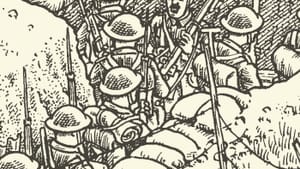Stay in the Loop
BSR publishes on a weekly schedule, with an email newsletter every Wednesday and Thursday morning. There’s no paywall, and subscribing is always free.
The face of war, seen from the trenches
Joe Sacco’s ‘The Great War’

The Great War is actually a 24- foot drawing, divided into 24 narrative panels, each crammed with mind-boggling detail. The Australian-born artist Joe Sacco cites The Bayeux Tapestry’s depiction of the Norman invasion of Medieval England as his direct inspiration. He might also have added Dante’s Inferno.
As you unfold the panorama, things begin quietly enough with the British commander General Douglas Haig walking alone in the garden of the chateau that serves as his headquarters. The general is thinking. Soon enough we see his thoughts solidifying into supply wagons, cannons and marching men, all headed to the front.
Night falls and a new day begins. Plates 13 to 19— seven feet of illustration, if you’re counting— depict a vision of hell on earth. Exploding German shells create geysers of fire and earth; and wending through them all, like a column of ants, the British infantry advances. (Military police are brought in to dissuade soldiers tempted to flee.)
The wounded who can still walk are expected to make their own way back to the dressing and clearing stations.
Repaying Lafayette
The dead are casually tossed over the sides of the trenches so that the living can get on with the business of killing. Some 21,000 British troops died on the first day of the Battle of the Somme. The panorama concludes with the grave-digging detachments hard at work.
Aside from its intrinsic worth as a work of art, the great value of this book for Americans is the light it throws upon what this war meant to England and, by extension, Europe.
To Americans, World War II will always be “The Big One.” This was our war— the war we fought and won. World War I, on the other hand, was a sort of “Boy’s Own Adventure” (except for the men who fought it, most of whom are gone now): We Americans bailed the Europeans out. We repaid our debt to Lafayette.
Who gets the girl?
For Europe, on the other hand, World War I changed everything. It marked the end of European dominance over world affairs. It killed a generation of young leaders from every nation that fought in it. When you unfold the panels of Sacco’s work, you are seeing a social order destroying itself.
All the grand talk of The Big Push that became “The Great Slough,” all the week-long bombardments that didn’t quite destroy what they were supposed to destroy, all the bravado of “First Man to Win the V.C. Gets the Girl” and “First Company to Kick a Soccer Ball into the German Trenches Gets a Prize”— all worked out to nothing.
(Although the French portion of the offensive did succeed in re-capturing about six miles of front-line real estate, making the day, on the whole, an Allied victory.)
But in the end, Clint Eastwood’s line— “I’ve never seen so many men wasted so badly”— could stand as the epigram to this art book with a message.
What, When, Where
The Great War—July 1, 1916: the First Day of the Battle of the Somme. By Joe Sacco. W.W. Norton and Company, 2013. 54 pages; $35. www.amazon.com.
Sign up for our newsletter
All of the week's new articles, all in one place. Sign up for the free weekly BSR newsletters, and don't miss a conversation.
